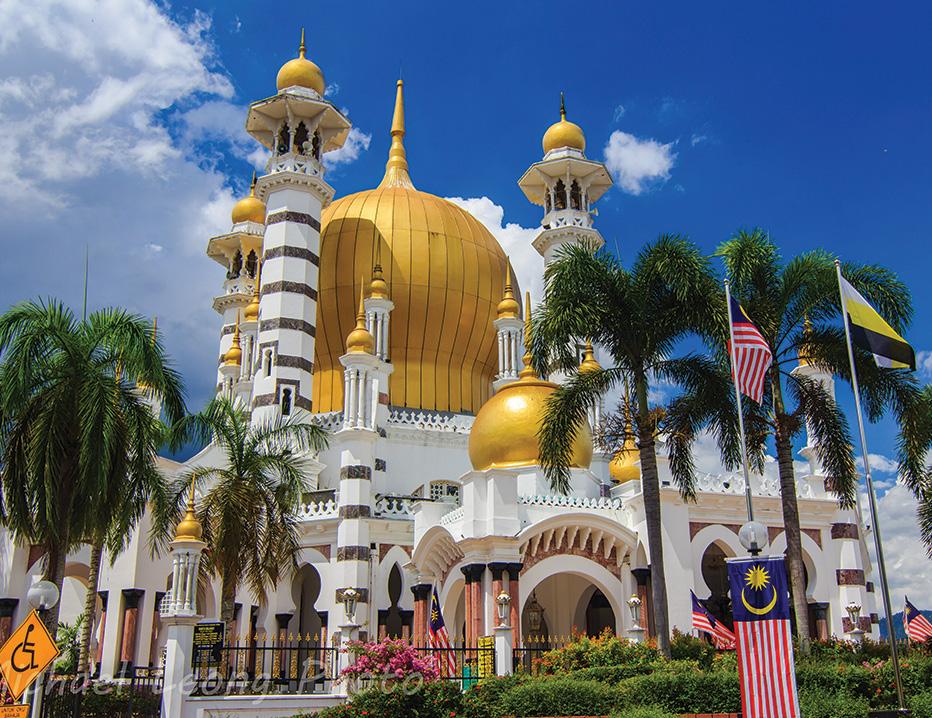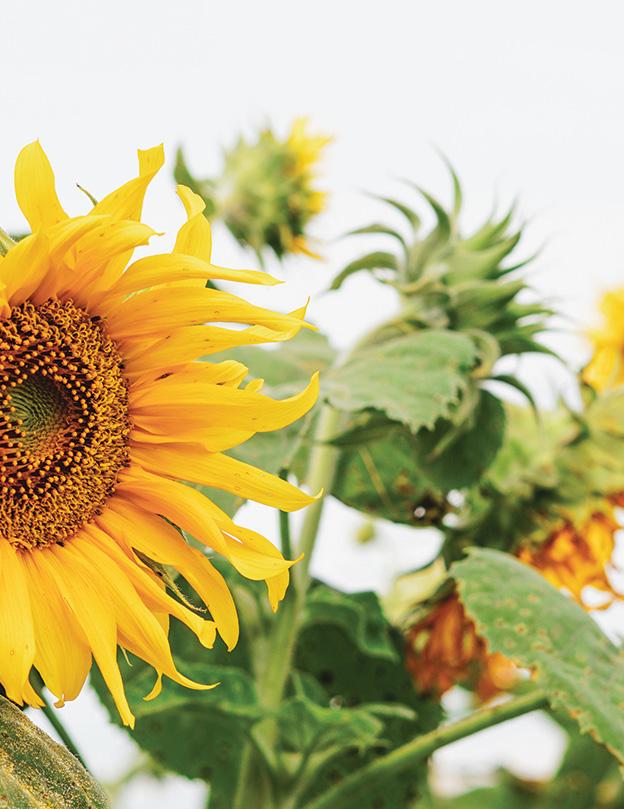
16 minute read
Trip To Teluk Intan & Bagan Datuk With
Trip to Teluk Intan & Bagan Datuk
With Tourism Perak
Advertisement
Text by FARHANA FUAD Images by MUHAMMAD HASIF MOHD JELANI
Some would think that travelling is an attempt for us to escape from our hectic life. It is the time for relaxation and pleasure but to me, travelling is not only that. I take travelling as a valuable opportunity to widen my horizons and learn more about the world and life, just like the saying “we travel not to escape life but for life not to escape us”. As someone who loves travelling, even a two-day escape is a blessing that I definitely can’t miss.
My first trip with Gaya Travel Magazine took up to four days and three nights, which was enough to fit in many activities. The trip, which was organised by Tourism Perak in collaboration with Gaya Travel Magazine, was to Teluk Intan and Bagan Datuk in the Malaysian state of Perak. Teluk Intan is a provincial town famous for its Leaning Tower, but did you know that there is more to the place? Interestingly, the downstream part of the 400-kilometre Perak River meanders through Teluk Intan and finally meets the sea at Bagan Datuk.
Read on to find out what you can do in Teluk Intan and Bagan Datuk, which we hope might bowl you over…
We started our first activity by going on a river cruise that is operated by Sahril Pekan Enterprise. Since the Perak River cuts through Teluk Intan, why not take this opportunity to cruise along and be fascinated by the vestiges of the historical port that dot along the river, including catching a glimpse of egrets flying back home to Bangau Island (a sanctuary for migratory birds), followed by witnessing fireflies at the riverbanks when it gets dark?
I got the chance to cruise on the same boat as Mr Sahril, our tour guide. The cruise takes passengers to different sites and places along the riverbanks. Along the way, we saw a row of freshwater fish farms reaching out towards Bangau Island. Travellers intending to see the amazing sunset (if weather permits) and thousands of birds flying above as they return to Bangau Island, it is advisable for them to be there after 6:30 p.m. The tour ends after passengers witness the fireflies.
During the cruise, Mr Sahril briefly told us how the name Teluk Intan’ çame about. Teluk Intan was once known as ‘Teluk Mak Intan’ after a rich widow from Mandailing in Sumatera who was beautiful. The local merchants in the area were crazy about her to the point that even the British were into her as well, but she played hard to get because she was already rich, hence independent.
After the British came to the area, the name was changed to ‘Teluk Anson’ in honour of Sir Archibald Edward Harbord Anson, Governor of the Straits and also the first district officer of Teluk Intan. Sir Edward Anson developed the rail infrastructure linking Tapah Road and Teluk Intan so that tin and raw materials can be transported out.
Teluk Anson then had a big port and similar in stature with Port Dickson and Port Klang. However, with the advent of modern road systems, the rail line as well as the port were rendered obsolete, thus eventually closed, ending the glory days of Teluk Anson. Its name was then changed to Teluk Intan with the consent of the Sultan of Perak. From the boat, the guide pointed out to the historical sites along the river; the first place was the three piling poles situated on the riverbank. He explained that the poles are the former port known as Anson Port. One unique thing about Perak River is that the river is deeper along its banks compared to the middle, capable in accommodating merchant ships coming from Europe. The water level can reach the depth of 100 feet, which is equivalent to a three-storey building.
During the cruise Traveller might notice many boats along the river because people are fishing for lobsters, fish and more. As a matter of fact, the main activity along Perak River is lobster fishing. Lobsters in Perak River are not dependent on season, therefore always available. This is attributed to Perak Fisheries Department’s initiative in releasing as many as 50,000 to 100,000 lobsters every year for breeding, ensuring Perak River’s ecosystem and the fishermen’s livelihood are maintained.
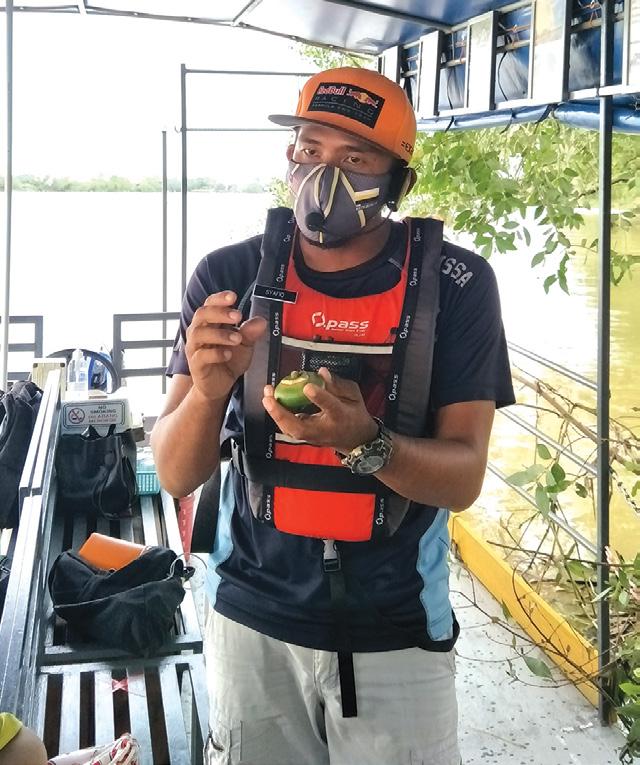
A guide from Teluk Intan River Cruise explaining about the different species of egrets perching on the trees at Bangau Island. As we continued, we saw deepsea ship factories that employ the traditional methods of ship-building using plywood. Mr Sahril shared that it takes around six to seven months to build one ship and can reach up to MYR800,000. We also passed by floating restaurants, tilapia fish farms, old ferry from Rawa Island, sandmining ship, and sunken train ship before finally reaching Bangau Island, the nesting ground of thousands of egrets.
Egrets fly out of the island as early as 6:30 a.m. to find food around Perak River and they would all return to the island beginning 6:30 p.m. These egrets lay eggs on the island, thus could not fly too far to find food. There are different species of egrets on Bangau Island and the guide told us that there around 40,000 to 50,000 of inhabiting the island. During my trip, it was breeding season, so my travel companions and I managed to see many egrets hanging on the trees.
As it got darker, fireflies began coming out, especially between 8:00 p.m. and 10:00 p.m., when they are the most active. There are two firefly species here: Pteroptyx Tener; and Pteroptyx Alba. The former blinks or flashes at the same time, while the latter flashes randomly. Mr Sahril also briefed us on the characteristics and fun facts about the fireflies.
To be able to ride on the cruise, you need to make a booking with Teluk Intan River Cruise, which offers four different packages ranging from MYR15 to MYR60 per person based on activities and places where they stop.
Operation day: Weekends, Public Holidays & School Holidays Operation Time: 8:30 a.m. – 8:30 p.m. For more info, visit https://www. facebook.com/rivercruisetelukintan


Clockwise from Top, Left: A tour guide telling the history of Sungai Kerawai Elephant Memorial; The front view of AlIhsaniah Madrasah; Church of St Anthony of Padua; Leaning Tower of Teluk Intan; Checking out the surrounding views from one of the floors on the Leaning Tower of Teluk Intan.
Teluk Intan Heritage Trail
Travellers usually make the effort to come to Teluk Intan for its famous Leaning Tower, take a few pictures and leave. However, there are actually more heritage buildings and interesting places that travellers can discover to appreciate the history and culture of Teluk Intan. A self-guided heritage trail led by Persatuan Pencinta Sejarah Masyarakat Perak (History Lover Society of Perak), in collaboration with Persatuan Pelukis Teluk Intan (Teluk Intan Painting Society), takes you to 20 different landmarks encompassing historical sites, war memorial, mosque, temples, churches and various cultural attractions in Teluk Intan, indicating that there is more to Teluk Intan than meets the eye!
The Heritage Trail begins with a journey to Sungai Kerawai Elephant Memorial, which used to be a railway line between Tapah Road Teluk Intan station. A year after the railway service became operational, a train crashed into some members of an elephant herd, which were killed on the spot. The leader of the herd then went on a rampage and crashed into the same train the next day, causing the train to derail.
As a result of the collision, the skull and tusks of the dead elephant are currently displayed in Taiping Museum, while its one metre hip bone is displayed at Johor Bahru KTMB mini museum. The British erected a memorial with a signboard indicating the place where the accident happened. Travellers can view the remnants of the railway line along with a brief description of the incident here.
The next landmark is the Al-Ihsaniah Madrasah, the first modern madrasah (Islamic religious school) in Perak that was built in 1901. The original structure of the Al-Ihsaniah Madrasah that made up of leftover wood. It was later rebuilt with better materials resulting in the current structure seen today that
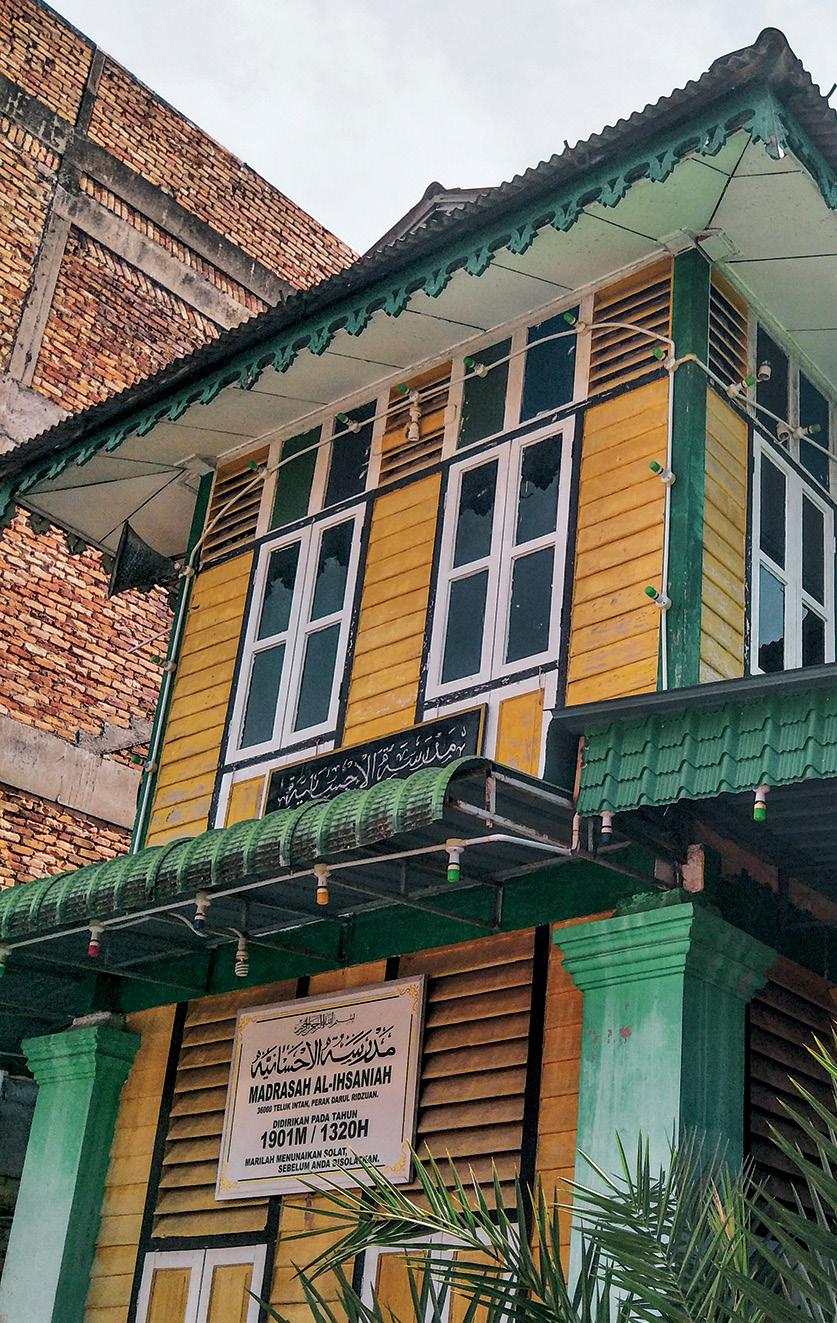


has stood the test of time.
Walking across the road in front of the madrasah is the Hock Soon Temple, built as early as 1883. The most significant feature of the temple is the Southern Chinese architecture with arches and classical columns to support the building. The main hall is designated for worshipping the deities while the front courtyard towards the right side of the temple stood an eightmetre tall Buddha statue, the tallest in Malaysia.
The Lower Perak District War Memorial, or also known as Batu Tenggek Teluk Intan by the locals, sits along Jalan Changkat Jong near Jalan Maharaja Lela. The monument consists of one granite stone that rests on a dressed stone, then placed on concrete. A long time ago, it was said that the granite stone was only the size of a match box but in time grew to its current form. The War Memorial commemorates the lives lost during the First and Second World Wars.
The next stop is the Old Police Station, the earliest building erected by the British. Upon its completion, it was first used as a taxation and customs office for the Port of Teluk Intan. The building was then repurposed into a police station until it was finally abandoned. Currently, visitors can only see it from afar since the building is locked. Next to it is the Post Office; in its early days, services provided were sending of mails, voter registration and even buying lottery tickets. Adjacent to the post office is the HSBC Building, constructed in 1948 and remains unchanged until today.
The tour guide later brought my travel companions and I to several old churches and temples around the same area such as The Church of St Luke the Evangelist, Tamil Methodist Church, Church of St Anthony of Padua and Sri Thendayuthapani Temple. We were able to learn a great deal about the history and unique stories about these landmarks and were in awe by of their architecture. We took selfies at everywall, path and corner of these buildings so that we could upload them on our social media.
Since our time was limited, we ended the Heritage Trail by visiting the Leaning Tower of Teluk Intan, which has a clock at the top that chimes every 15 minutes. The clock tower was originally used as a water tower to supply water to the town area. Teluk Intan Leaning Tower started to tilt four years after its construction finished due to an underground stream. There was a large flood happened that made the water tank heavy, tilting the tower on one side. The tower no longer stores water and is currently a local tourist attraction.
For more info about the Teluk Intan Heritage Trail, visit https://www.telukintanheritage.com/.
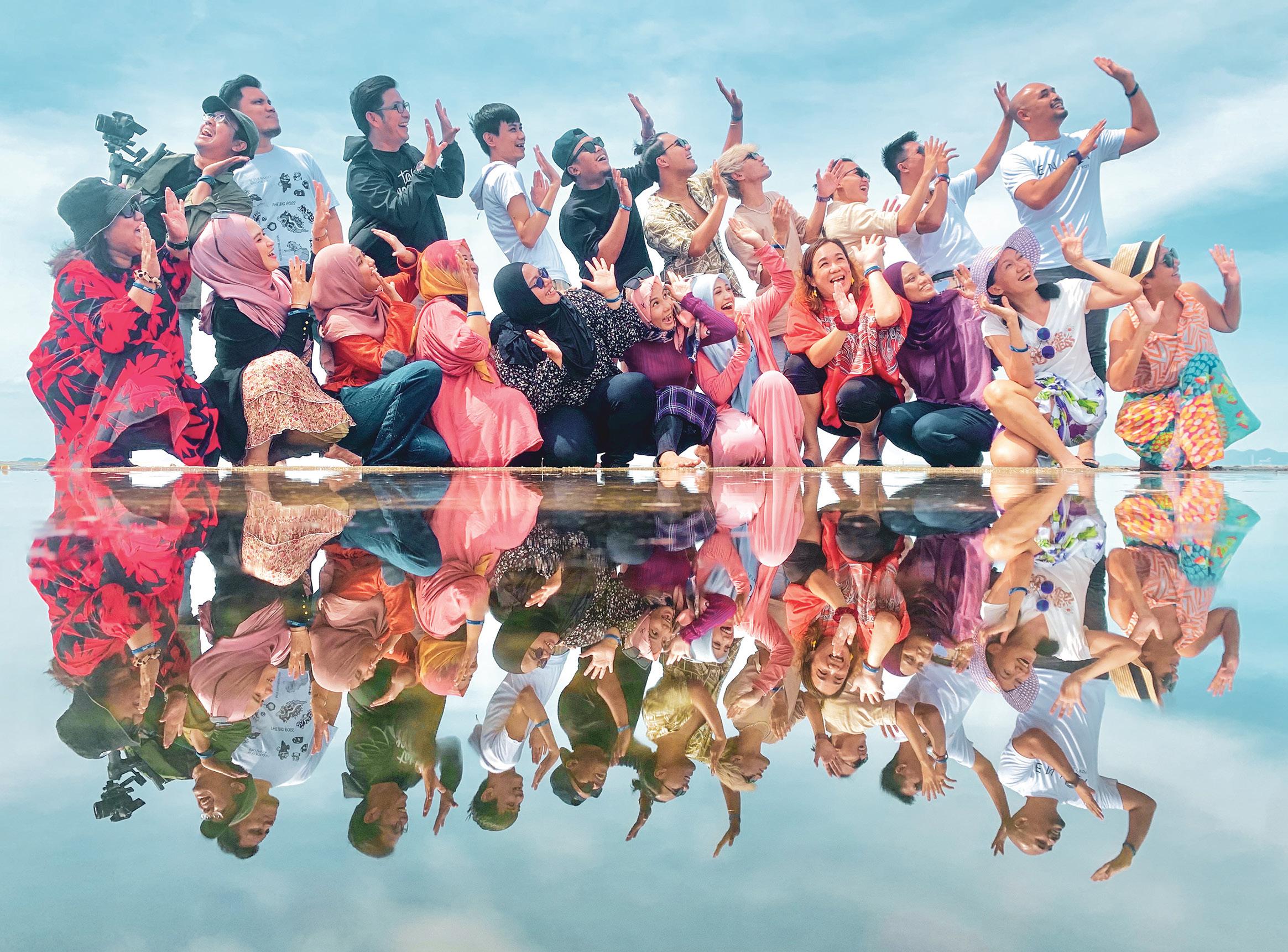
The participants during the trip to Teluk Intan and Bagan Datuk striking a group pose at the Sky Mirror in Sungai Burung Village, Bagan Datuk.
Bagan Datuk Waterfront
Bagan Datuk is a small, quaint town located about an hour’s drive from Teluk Intan, so we include it in our itinerary. What appeals to us is that the town boasts an area called Bagan Datuk Waterfront where travellers can have a short stop to chill and take pictures of the colourful Bagan Datuk signage and shophouses, including art murals that grace the walls near the waterfront. Be sure to catch the sunset view and enjoy the night atmosphere of this town too!
Sky Mirror in Sungai Burung Village
From Bagan Datuk Waterfront we proceeded to Sungai Burung Village where we had our lunch prepared by the Nine Island Agency consisting of Muslim-friendly dishes made by the villagers. Sungai Burung Village is a small fishing settlement with a population of around 400 people. Sungai Burung Village is an interesting destination for visitors to experience the fun-filled ‘sky mirror’’ photo opportunities and stop by the scenic sunflower garden, one of Bagan Datuk’s emerging tourist attractions.
We revelled in fun photography session at Sky Mirror in Sungai Burung Village, Bagan Datuk with Nine Island Agency. Within 15 minutes on a boat ride, we reached a knee-deep water spot where we had to wade towards an area where shallow waters can be found. Standing in the middle of the sandbank with water around my ankle feels like I was about to sink into the sea. However, as soon as we reached the area, the organiser started creating a puddle filled with water so that we could take excellent mirror-like reflections that were truly memorable! For more info about the Nine Island Agency and other activities it offers, visit https://www.facebook.com/ Nineislandagency or contact Cindy at +6 017 622 0815.
Sunflower Garden in Bagan Datuk
We ended our day at the Sunflower Garden, arguably the highlight of our trip in Bagan Datuk district. I found myself magically transported to a dreamy realm when standing amidst tall sunflowers. The mesmerising view of this 0.8-hectare garden filled with over 2,000 giant sunflowers makes it an ideal location for taking wedding pictures for newlyweds,

Top: Some of the participants taking a wefie in the middle of the sunflower garden. Middle: Kayaking activity at Ladang Moccis.Bottom: One of the participants, Ekmal Suhaimi, feeding the deer at Ladang Moccis petting zoo.
on top of taking Instagram-worthy selfies. Sunflower Garden opens every day from 9:00 a.m. to 7:00 p.m. with entrance fees ranging between MYR5 to MYR13 according to age.
Ladang Moccis
Ladang Moccis provides the best place to relax and escape from the city. Visitors can rent BBQ set, kayak, bicycle, ATV and fishing equipments while staying here. There is also a Mini Zoo that showcases deers, Bengal cats, rabbits, and other kinds of animals here. Ladang Moccis also provide a total of 10 homestay units for accommodations. 1 unit of the homestay comes with 3 rooms, private bathroom, and air-conditioner. Homestay fees ranges from RM200 – RM300 depending on unit sizes. In short, our time in Teluk Intan and Bagan Datuk was definitely worthwhile! Though both destinations might not be as popular as other cities in Malaysia, they have so much to offer, hence deserve more attention among local and foreign travellers. Be sure to visit these charming destinations when you head to Perak soon!
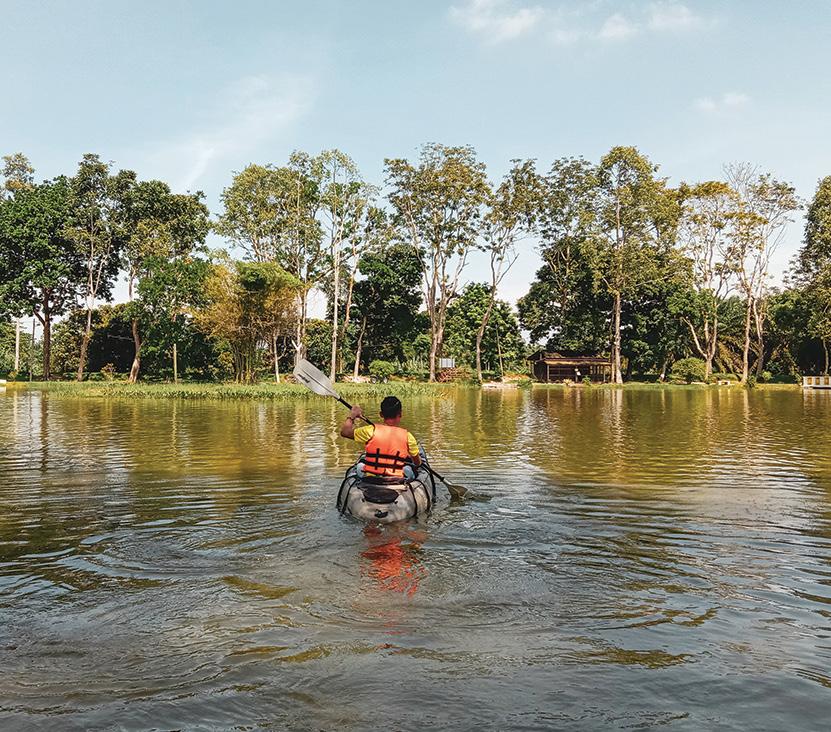
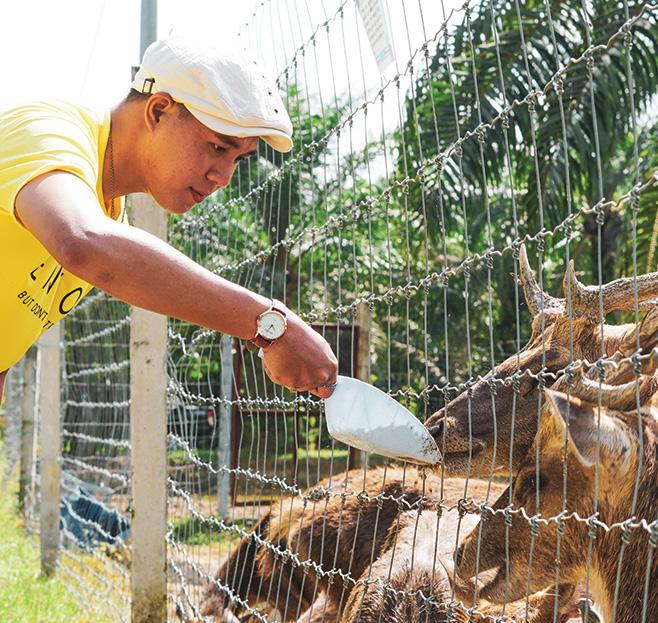









COVID-19 PANDEMIC:
IPOH CITY RECOVERY PLAN
The Movement Control Order (MCO) imposed by the Malaysian government in mid-March 2020 to contain the Covid-19 outbreak had profound consequences on many sectors of the economy, with tourism industry being the most badly affected. Travel ban and restrictions have led to a large drop in the number of tourists visiting Malaysia. However, though borders remain closed at the time of writing, domestic tourism is now allowed to resume operations. With the economy-wide stimulus packages rolled out by the government, the tourism sector is beginning to regain its foothold.
Affordable accommodation offered by hotels and resorts – including attractive travel packages – have allowed people in the B40 and M40 groups to enjoy the benefits of travelling to popular destinations within Malaysia. Nevertheless, due to the uncertainties brought about by the pandemic, Standard Operation Procedures (SOPs) are strictly enforced in hotels, resorts, campsites, restaurants, eateries and transportation to break the Covid-19 chain.
In response to the challenges brought about by the pandemic and economic downturn, Ipoh City works hard to improve its tourism industry under the leadership of the 12th Mayor, YBhg. Dato’ Haji Rumaizi bin Baharin @ Md. Daud, who is committed to attracting more people to visit and even invest in Ipoh City by putting in place short-term and long-term planning to make the city more sustainable and liveable. YBhg. Dato’ Haji Rumaizi envisions Ipoh City to become the third most well-known tourism city in Malaysia by 2025 via the 3H concept: Hipster, Heritage and Health.
Tourism industry is vital in lifting the economy because tourists, either local or foreign, spend on accommodation, sight-seeing, food, and purchasing items like memorabilia or souvenirs. The revenue generated from these activities are channelled back towards developing and upgrading the city’s infrastructure to create more jobs for locals and enhance their quality of life.

Although Ipoh City is popular for its culinary offerings, efforts are being made to find ways for tourists to spend more nights in Ipoh City not only for its food but its rich heritage as well that tourists can experience before heading to other destinations. As such, YBhg. Dato’ Haji Rumaizi declared that tourism development in Ipoh City to concentrate within the Ipoh Tourism Triangle covering recreational sites such as Gunung Lang; Ipoh Padang and its surroundings; D.R. Seenivasagam Park; and Kampung Kuchai, particularly the Panglima Kinta Mosque and its historically-rich vicinity.
Several of the projects are already under way and will be completed by early 2021. These include the Petting Zoo at Gunung Lang; the Kinta Riverwalk; and the light-and-sound features at Ipoh Padang. As for Kampung Kuchai, discussions are being held to designate this area for ecoheritage tourism.
One thing that snap-happy tourists should not miss in Ipoh is to follow the two-hour Heritage Trail around Old Town, which leads them to the area’s unique charms, for instance the mural drawings that grace the back-lane of the shophouses, irresistible souvenirs on sale at Concubine Lane, and a shop featuring accessories displayed upside down. Hipster cafes can be found along the Heritage Trail too, which are magnets for youths and the young at heart generation.
On top of that, Ipoh City Council collaborates with other local district authorities in the State of Perak such as Batu Gajah, Kampar and Kuala Kangsar to promote tourism products within the respective districts under a pilot project known as Greater Ipoh. Each of the mentioned districts has its own identity and attractions ranging from geopark to culinary and heritage.
Ipoh City is only two hours by train from Kuala Lumpur and an-hourand-a-half drive along the highway from Penang. Both domestic and international tourists can enjoy various cuisines and spend a night or more when savouring the delights of Ipoh City before departing elsewhere.
For more information, visit http://www.mbi.gov.my/en.
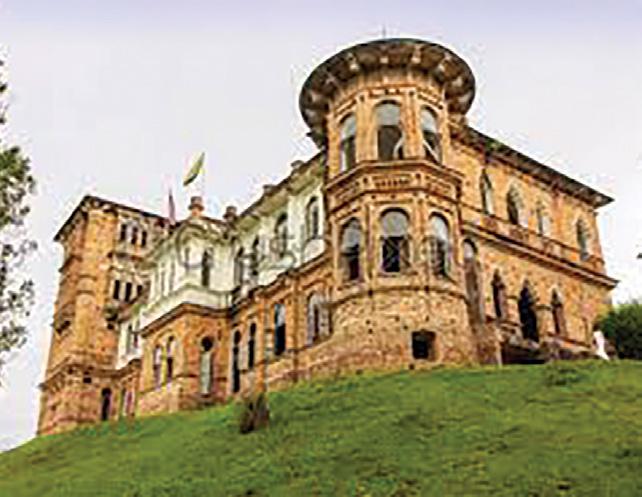

Kellie’s Castle, Batu Gajah Gaharu Tea Valley, Kampar Ubudiah Mosque, Kuala Kangsar
